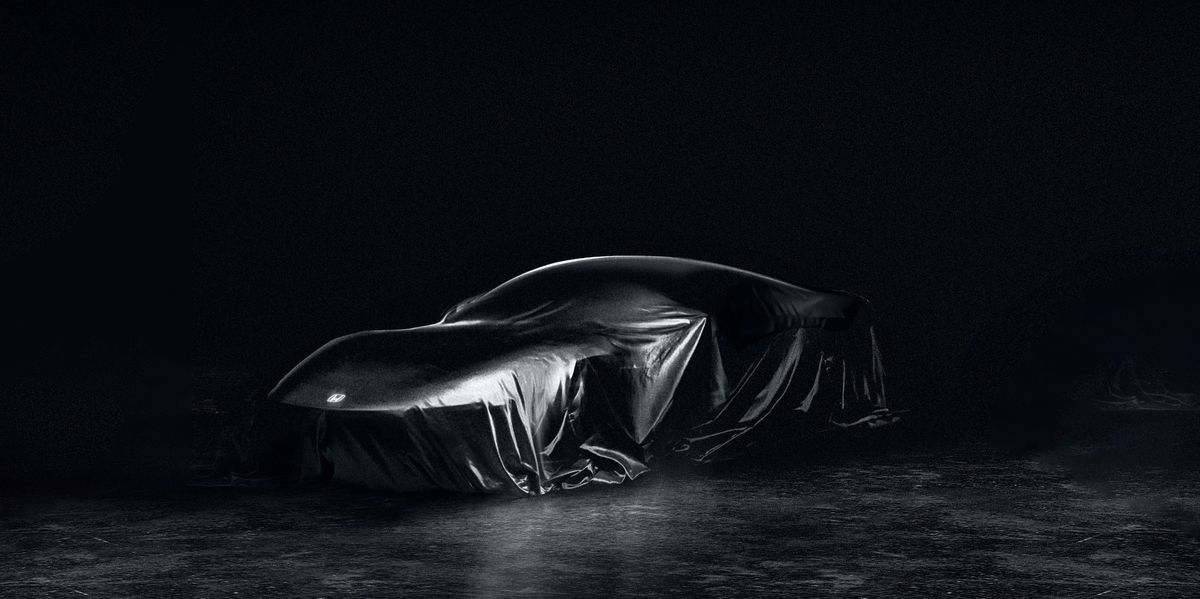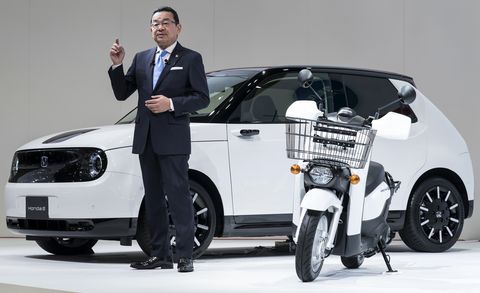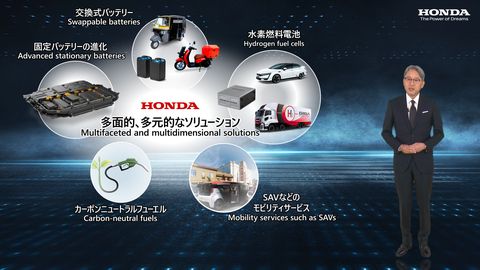Honda Lays Out Its Plans to Join the EV Race

Honda has sometimes been characterized as a company that builds internal-combustion engines, and sells them in a variety of packages. That makes the transition to battery-electric vehicles a particular challenge for Honda.Few other global automakers, if any, sell ICE-powered products ranging from SUVs to marine engines to stationary generators. Until 20 years ago, it even sold chainsaws.On Monday, three Honda executives revealed plans for an array of future vehicles that plug in rather than refuel.
Honda
The headline is that Honda—which sells precisely one EV today, the Honda e, a two-seat sports car not offered in North America—will launch 30 electric vehicles globally by 2030. Their collective volume will be more than 2 million units, out of a typical annual Honda production of 5 million. This comes, mind you, from a company that limited production of its compliance-car Fit EV to 1400 units and whose subsequent 2018 Clarity Electric mid-size sedan was pulled from the market after its EPA-rated range of 89 miles proved uncompetitive.

Honda e at the Tokyo auto show, 2019.
Tomohiro OhsumiGetty Images
Among those 30 future electric vehicles will be two “sporty” EVs, one of them a successor to the Acura NSX that has just departed the market. Expect the bulk of the new EVs to be crossover utilities, however, in line with the global market trend.
In North America, Honda plans to work with General Motors on two generations of EVs. First come two battery-electric SUVs: the Honda Prologue and a so-far-unnamed Acura, both to be launched in 2024. Those will be built by GM on the Ultium architecture that underpins the GMC Hummer EV, the Cadillac Lyriq, the Chevrolet Silverado EV, and many more vehicles. But those plans have been known for a while now.
Then, last week, Honda and GM announced they would partner on a new generation of lower-cost, higher-volume EVs to launch starting in 2027. Those will use the next generation of Ultium battery cells in smaller and more affordable models than even compact vehicles like the Chevrolet Equinox EV crossover due next year.
GM will provide its Ultium cells for Honda’s North American EVs, but the Japanese company says it’s also “exploring” a joint-venture cell production venture that doesn’t include GM. Honda also said it will set up a low-volume pilot line for solid-state battery cells, undoubtedly in Japan, with demonstration production targeted for spring 2024.
The executives did not address the recently announced joint venture with Sony that is expected to lead to a new EV of some kind by 2025, or how that vehicle fits into these plans.

Honda
At Home, Tiny EVs First
In its home market of Japan, Honda will launch EVs at the other end of the scale: the kei class, or minicars, hugely popular there but rarely sold in volume elsewhere. The first is to be a mini-EV for commercial use, likely a kei van, targeting a price of 1 million yen ($8000). It will be followed by a variety of other models for personal use, including mini-SUVs.
In China, by far the world’s leading EV market today, Honda will introduce 10 new EV models by 2027, to be built at dedicated plants in Guangzhou and Wuhan. Oddly, European markets weren’t mentioned at all in Honda’s press materials.
The underlying technologies for these various vehicles aren’t specified, but the company notes it will expand use of the “Honda e: Architecture” now used for the Honda e to other vehicles. That EV platform combines hardware and software—which ties into another part of an ambitious restructuring of the company.
Honda said it will “strive to transform” its business from selling “non-recurring hardware” (meaning vehicles) to “recurring” businesses in which it offers “various services and value” to customers after sale. This seems to mean, in essence, that Honda hopes to make as much money from charging for services and features as it does from selling the vehicles in which they’re offered.
One hypothetical example: Want particular safety or navigation features? Previously, you bought them as part of the car; now, you’ll pay for them monthly or annually. Honda’s not alone here. Most other makers are hungrily eyeing the monthly fees earned by content providers, device makers, and others. Honda’s just being a bit more explicit about it.
Honda and Toyota: EV Laggards, Hydrogen Proponents
Honda’s announcement on EVs follows a similar presentation by Toyota only four months ago. Both companies have historically been among the auto industry’s staunchest proponents of hydrogen fuel-cell vehicles as the zero-emission technology of choice—by 2035 or so—and among its most vocal foot-draggers on vehicles that plug in.
But today, the world has perhaps 30,000 or 35,000 HFCVs on its roads, against more than 10 million EVs, with 2 million more EVs to be added this year alone. Meanwhile, hydrogen faces enormous hurdles as a fuel for personal use vehicles.
So for Honda to stay true to its 10-year slogan of “Blue Skies for Our Children” as the deadline for meaningful climate action barrels ever closer, the company had no option other than electric vehicles. They’re the only way it can offer products that comply with various countries’ goals of selling only zero-emission vehicles by 2030 or 2035.
The company is clearly devoting significant capital to these transitions. It pledged that 5 trillion yen ($40 billion) will go toward electrification and software technologies over the next 10 years, out of a total R&D budget of 8 trillion yen ($64 billion) for the period.
Note, however, that “electrification” doesn’t mean electric cars. It means any vehicle that has an electric motor anywhere in the drivetrain. For Honda, that likely means much higher volumes of conventional hybrid vehicles in the near and medium terms—and probably more plug-in hybrid models as well. In that respect, it very much echoes the plans from the acknowledged world leader in hybrids, Toyota.
Honda’s commitment over 10 years compares to pledges of $35 billion by 2030 from both Toyota and General Motors. It builds only half the number of cars globally that Toyota does, so its more cautious partnerships with GM for North America make sense.
But Honda had to come out with its own plans in the face of similar pledges from other global makers. At the top is Volkswagen at $59 billion, followed by the $35 billion gang—Toyota, GM, and Stellantis—and Ford just behind, at $30 billion. Nissan, a notable EV pioneer with its 2011 Leaf (which has just been tweaked for its 13th model year!), lags at $19 billion, but it has bigger problems to solve as a company right now than EVs.
We note, however, that while Honda nodded to electrification for its motorcycles through standardized battery swapping, it nothing about plans for generators, ATVs, or aircraft. No doubt that’ll be another presentation.
This content is created and maintained by a third party, and imported onto this page to help users provide their email addresses. You may be able to find more information about this and similar content at piano.io



